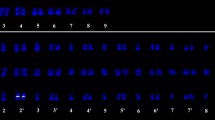Abstract
Infraspecific cytogenetical variation was studied in a diverse collection of five non-cultivated and cultivatedCucumis sativus accessions. The individual chromosomes of different accessions could be identified by the C-banding pattern and chromosome measurements. About 40–50% of the genomic area are made up of heterochromatin inC. sativus. The non-cultivated accessions exhibit more heterochromatin and lower chiasma frequencies per pollen mother cell than cultivated accessions. There is infraspecific variation in C-banding pattern, karyomorphology and multinucleolate cells. The use of C-banding in infraspecific classification is discussed.
Similar content being viewed by others
References
Boos, G. V., 1959: On the classification of cucumbers. — Trud. Priklad. Bot. Gen. Sel.32, 80–86.
Brandenburg, W. A., 1984: Biosystematics and hybridization in horticultural plants. — InGrant, W. F., (Ed.): Plant Biosystematics, pp. 617–632. — Canada: Academic Press.
——, 1982: Taxonomic aspects of the germplasm conservation of cross-pollinated cultivated plants. — InPorceddu, E., Jenkins, G., (Eds.): Seed Regeneration in Cross-pollinated Species, pp. 33–41. — Rotterdam: Balkema.
Brickell, C. D., (Ed.), 1980: International Code for Nomenclature of Cultivated Plants. Formulated and adopted by the International Commission for the Nomenclature of Cultivated plants of the I.U.B.S. — Regnum Vegetabile104. — Utrecht: Bohn, Scheltema and Holkema. The Hague: Dr. W. Junk BV, Publ.
De Candolle, A., 1882: Origine des Plantes Cultivées. — Paris: Germes Baillière, pp. 377.
Filov, A. I., 1967: Herkomst en ecologische evolutie van de komkommer (Cucumis sativus L.). — Bull. Glav. Bot. Sad66, 31–37.
Gabaev, S. G., 1929: Cucumbers from Asia. — Trud. Priklad. Bot. Gen. Sel.23, 443–473.
Giorgi, B., Bozzini, A., 1969: Karyotype analysis inTriticum I. Analysis ofT. turgidum (L.) and related tetraploid wheats. — Caryologia22, 249–259.
Greilhuber, J., 1973: Differential staining of plant chromosomes after HCl treatments (Hy-bands). — Österr. Bot. Z.122, 333–351.
Hemleben, V., Leweke, B., Roth, A., Stadler, J., 1982: Organisation of highly repetitive satellite DNA of twoCucurbitaceae species (Cucumis melo andCucumis sativus). — Nucl. Acids Res.10, 631–644.
Howell, W. M., Black, D. A., 1980: Controlled silver staining with a protective colloidal developer: a 1-step method. — Experientia36, 1014–1015.
Hutchinson, J., Narayan, R. K. J., Rees, H., 1977: Constraints upon the composition of supplementary DNA. — Chromosoma78, 137–145.
Ingle, J., Pearson, G. G., Sinclair, J., 1973: Species distribution and properties of nuclear satellite DNA in higher plants. — Nature New Biol.242, 193–197.
Jeffrey, C., 1980: Further notes onCucurbitaceae V. TheCucurbitaceae of the Indian subcontinent. — Kew Bull.34, 789–809.
Jones, B., Milkos, G. L. G., 1979: Functional aspects of satellite DNA and heterochromatin. — Int. Rev. Cytol.58, 1–114.
Mohan, J., Flavell, R. B., 1974: Ribosomal RNA cistron multiplicity and nucleolar organisers in hexaploid wheat. — Genetics76, 33–44.
Ramachandran, C., 1984: Nuclear DNA variation inCucumis. — Cucurbit Genetics Co-operative Report7, 97–99.
——, 1984: Satellite DNA sequence specific to knob heterochromatin inCucumis metuliferus. — Chromosoma50, 9–19.
--Seshadri, V. S., Pai, R. A., 1983: Giemsa C-banding inCucumis. — Proc. XV Intern. Congr. Genet., New Delhi (Abstr.).
—— 1984: Cytogenetical studies on dessert and non-dessert forms of muskmelon (C. melo L.). — Cytologia50, 9–19.
Rees, H., Jones, R. N., 1972: The origin of the wide species variation in nuclear DNA content. — Int. Rev. Cytol.32, 53–92.
Robinson, R. W., Bohn, G. W., Whitaker, T. W., 1980: Known genes ofCucurbitaceae. — Conference on the Bilogy and Chemistry ofCucurbitaceae. Cornell Univ., Ithaca, U.S.A.
Schwarzacher, T., Ambros, P., Schweizer, D., 1980: Application of Giemsa banding to orchid karyotype analysis. — Pl. Syst. Evol.134, 293–297.
Scott, N. S., Ravanagh, T. A., Timmis, J. N., 1984: Methylation of RNA genes in some higher plants. — Plant Sci. Lett.35, 213–217.
Author information
Authors and Affiliations
Rights and permissions
About this article
Cite this article
Ramachandran, C., Brandenburg, W.A. & den Nijs, A.P.M. Infraspecific variation in C-banded karyotype and chiasma frequency inCucumis sativus (Cucurbitaceae). Pl Syst Evol 151, 31–41 (1985). https://doi.org/10.1007/BF02418017
Received:
Issue Date:
DOI: https://doi.org/10.1007/BF02418017




